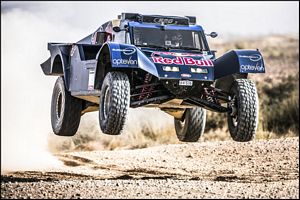|
By accessing or using The Crittenden Automotive Library™/CarsAndRacingStuff.com, you signify your agreement with the Terms of Use on our Legal Information page. Our Privacy Policy is also available there. |

Bringing The Dakar Rally To The World
|
|---|
|
|
Bringing The Dakar Rally To The World
Geoff Maxted
DriveWrite
December 22, 2013
Ever since the North African situation made it too dangerous to run the original route of the Dakar Rally, the event itself has gone from strength to strength at its new home in South America.
The images of the Dakar can surprise, shock and move people. As time has passed, they have conquered the channels of 190 countries, which invite their viewers to watch two weeks of hair-raising travelling and sporting feats. On this scale, the broadcasting of the rally has reached out to the four corners of the earth and moreover is continuing to improve its audience figures, mainly in the countries directly involved in organising the event. As a result, the Pan-American broadcasters have been increasing coverage and resources with each edition.
A newcomer to the route of the Dakar, Bolivia is also a rookie on the event through its public channel Bolivia TV, which, in addition to its daily programme, will be organising ambitious live broadcasts for the stages that the country will host. Revised and enhanced programmes will also be put in place not just there but in Paraguay (Téléfuturo), in Canada (Sportsnet, RDS), Poland (TVN), Slovakia (RTVS), Portugal (RTP), Italy (Italia 2) and Bulgaria (BNT). Notice any particular country missing from that list?
To satisfy viewers’ appetite for thrills, the production teams work each year on improving the quality and diversity of images broadcast, especially during the 26-minute long daily programme, produced with exceptional resources and in record times. Aerial views, interviews with the major players in the race but also amateurs, as well as historical and technical features are just some of the subjects that each day make up a menu that lucky viewers can savour in front of their screens.
Whilst the Dakar obviously attracts television cameras, the written press, radio stations and agencies also flock to the race in large numbers. Their photographers and reporters travel by plane or in press cars. In total, 400 permanent journalists are granted passes to cover the event.
TV resources include 3 helicopters and 5 TV cars, 13 cameramen positioned along the race’s sites, 11 on-board camera systems, 2 super slow-motion cameras (1,000 images per second), 7 satellite antenna and 21 editing suites. Additionally, there is 45 tonnes of equipment being used by 250 people.
There are hints of some coverage on Eurosport UK but how much live action or recorded highlights we’ll actually get is anyone’s guess. When is the UK media going to wake up to the fact that the various branches of motorsport are hugely popular in Great Britain. Man cannot live by F1 alone.


















 Topics: Dakar Rally
Topics: Dakar Rally

